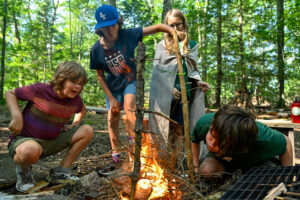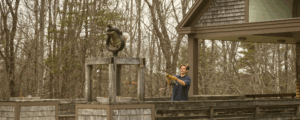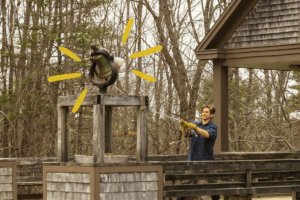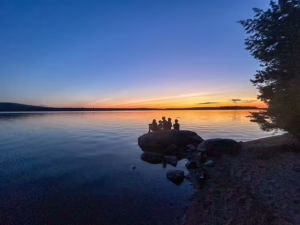
New Partnership with Maine Huts & Trails Brings Benefits to Both Teams
Chewonki is proud to announce a new partnership with Maine Huts & Trails, a Maine-based nonprofit with four backcountry lodges connected by an 80-mile trail network suitable for hiking, snowshoeing or skiing in Maine’s Western Mountains region.
Four of our Outdoor Classroom instructors, including Jen Adams, Conor Burke, Emmy Held, and Hannah Marshall will be joining the MH&T staff through the winter months, providing nature-based lessons to hut visitors and participate in trail maintenance, food preparation, and generally keeping skiers and snowshoers happy in three of the huts, which are modeled after Europe’s alpine trail huts but enhanced with creature comforts and state-of-the art, off-the-grid architectural design.
 Each member of the Outdoor Classroom crew chose a topic that particularly interests them, developed a lesson around it, and then practiced with Jessica Woodend and other Traveling Natural History Program staff. “They did great!” says Woodend, “They got really excited.” Hannah Marshall’s presentation focuses on snow science. As a Nordic ski-racing stand-out, she has a lifelong passion for snowflakes and speed. Connor Burke, who will work in the Flagstaff Lake hut, developed a presentation about the lake’s history, including the environmental and social impacts of creating it in 1949 by damming the Dead River. Jen Adams, a Registered Maine Guide, created a lesson about the first female Maine Guide, Cornelia “Fly Rod” Crosby, and the evolution of women’s presence in the guides’ ranks. And Emmy Held, who has extensive tracking experience, designed a presentation about how to detect animals and their activities in the wild.
Each member of the Outdoor Classroom crew chose a topic that particularly interests them, developed a lesson around it, and then practiced with Jessica Woodend and other Traveling Natural History Program staff. “They did great!” says Woodend, “They got really excited.” Hannah Marshall’s presentation focuses on snow science. As a Nordic ski-racing stand-out, she has a lifelong passion for snowflakes and speed. Connor Burke, who will work in the Flagstaff Lake hut, developed a presentation about the lake’s history, including the environmental and social impacts of creating it in 1949 by damming the Dead River. Jen Adams, a Registered Maine Guide, created a lesson about the first female Maine Guide, Cornelia “Fly Rod” Crosby, and the evolution of women’s presence in the guides’ ranks. And Emmy Held, who has extensive tracking experience, designed a presentation about how to detect animals and their activities in the wild.
Keith Crowley, Chewonki’s director of educational partnerships, and Johnson Whippie, the Outdoor Classroom field coordinator, are unabashedly thrilled by the new collaboration with Maine Huts & Trails. Crowley had for years tried to solve the riddle of how to keep great Outdoor Classroom staff when Chewonki needs them only in spring, summer, and fall. He proposed the partnership last winter and was was delighted when the Maine Huts & Trails representatives “didn’t laugh us out of the room,” he says. In fact, adding more know-how to its staff will help the relatively young organization meet its educational goals.
For these four Outdoor Classroom staff members, the wintertime jobs mean “sustainable, full-time employment…with a phenomenal partner organization,” says Whippie. They will return to Chewonki in the spring for the next Outdoor Classroom season with more professional experience to draw from as they start the new season. It seems like a match made in heaven.
We encourage you to visit the Maine Huts & Trails website to learn about all the cool things you can do in the Western Mountains this winter. When you get out there, give Hannah, Emmy, Conor, and Jen a big hello from Chewonki!
Can You Feel Your Fingers?

Our friends from Maine Huts & Trails have some excellent advice about staying warm while engaging in winter sports:
Dressing for cold temperatures may seem a bit intimidating, but fear not adventurers, with a little preparation, you can make your trip enjoyable (and warm).
The key to keeping warm on the trails is movement and staying as dry as possible. Whatever clothing you choose, layering helps regulate body temperatures and keeps clothing dry. When choosing your base (core) layer, think thin and lightweight (wool/poly). Your next layer could be a lightweight fleece/poly shirt or jacket. Next, add a lightweight vest or jacket. Top everything off with a waterproof or water/wind resistant layer. This system makes it easy to peel and adjust layers as you go.
When getting ready to make your way to the hut, you may feel a bit chilled at the trailhead. Resist starting out wearing too many layers. Start out cold. Once you begin snowshoeing, skiing or biking, your bodies engine will heat you up quick. If you begin to sweat too much, then it is time to peel off another layer. Layering also applies to your hands, face, and feet. Keeping you and your layers as dry as possible is always a top priority.
If adventuring in the cold is new for you, taking time to practice your layering system is valuable. Everyone tolerates temperatures differently. For instance, women tend to have colder fingers and toes. Figuring out what works ahead of time to keep your digits toasty can make all the difference.
Other key ingredients when temps dip low:
Hand or Toe Warmers: These single-use packs activate when exposed to air. They slip into your gloves or boots and last for hours. (gear nerd alert – here is a great article on how these little guys work)
Extra clothes: Having a backup base-layer or mid-layer can help if you get too sweaty. Changing into dry clothes can mean the difference between staying comfortable in the elements or becoming hypothermic.
Cover your face: Face masks, Balaklava or a scarf. If the wind is blowing hard, covering all exposed skin is important. Frost-nip or frostbite can happen when skin is exposed to cold wind. Luckily, an easy remedy is making sure skin stays covered.
Water: Staying hydrated keeps your body warmer – promise. Water freezes, but gear companies have thought of everything. Insulated water bottle holders or Insulated water bladders & hoses will help to keep water from freezing. A cool tip- keep your water bottle turned upside down. This helps keep the cap from freezing so it can still open to take a sip.
Huts are heated: Warm wood stoves, radiant floor heat, gear drying rooms and hot chocolate. Once you arrive at the hut, you are able to quickly warm up and reflect on what you have accomplished.
Enjoy the winter & we will see you on the trails.
For more information on what items you will need at the huts, be sure to check the packing list.











